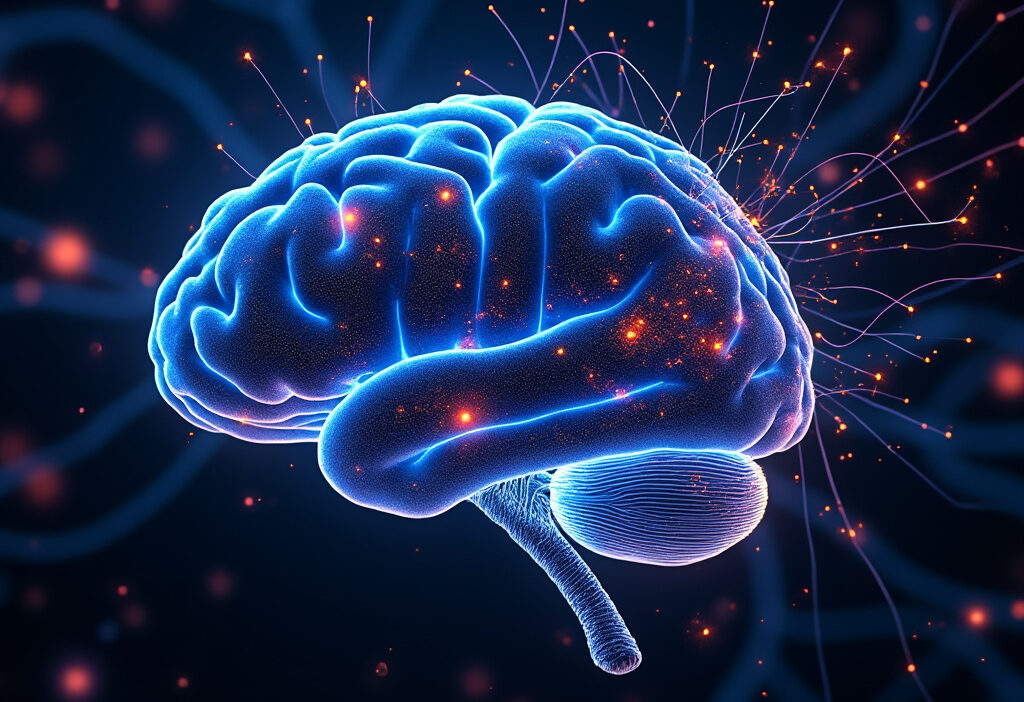Neuromorphic Computing The Future of Brain Inspired Technology
Neuromorphic computing represents a groundbreaking approach in technology, drawing inspiration from the human brain’s structure and functionality to revolutionize computing. This article delves into the essence of neuromorphic engineering, its applications, and how it stands to redefine the future of artificial intelligence and computing systems. By mimicking biological neural networks, neuromorphic computing promises unparalleled efficiency and adaptability in processing information.
The Foundations of Neuromorphic Computing
The foundations of neuromorphic computing lie in the quest to bridge the gap between biological intelligence and artificial systems. Unlike traditional computing, which relies on rigid architectures like von Neumann machines, neuromorphic computing draws inspiration from the parallelism, adaptability, and energy efficiency of the human brain. The concept was first introduced by Carver Mead in the late 1980s, who proposed using analog circuits to emulate neural behavior, marking a radical departure from digital logic.
At its core, neuromorphic computing is built on three key principles:
- Event-driven processing: Instead of continuous clock-based operations, neuromorphic systems process information asynchronously, responding only to changes in input—much like biological neurons firing spikes.
- Massive parallelism: The brain’s power comes from billions of interconnected neurons working simultaneously. Neuromorphic architectures replicate this by distributing computation across numerous simple, interconnected units.
- Plasticity and learning: Synaptic weights in biological systems adjust over time, enabling learning. Neuromorphic systems integrate memristors or other adaptive elements to mimic this plasticity.
Traditional computing struggles with tasks like pattern recognition and sensory processing, where the brain excels. Neuromorphic systems address this by embracing non-linear dynamics and stochastic behavior, which are inherent to neural networks. Early implementations used analog circuits to model ion channels and synapses, but modern approaches leverage mixed-signal and even purely digital designs to balance biological fidelity with scalability.
This paradigm shift isn’t just about hardware—it redefines how computation is conceptualized. By moving away from sequential processing and embracing brain-like architectures, neuromorphic computing opens doors to low-power, real-time AI systems capable of autonomous learning, setting the stage for the next leap in intelligent machines.
How Neuromorphic Systems Mimic the Brain
Neuromorphic computing systems achieve brain-like functionality by emulating the fundamental building blocks of biological neural networks: artificial neurons and synapses. Unlike traditional computing, which relies on rigid binary logic, neuromorphic architectures process information through dynamic, event-driven interactions that closely resemble the brain’s behavior.
At the core of these systems are spiking neural networks (SNNs), where artificial neurons communicate via discrete electrical pulses, or spikes, rather than continuous signals. These spikes encode information in their timing and frequency, mirroring the way biological neurons transmit data. The leaky integrate-and-fire (LIF) model is a common approach, where a neuron accumulates input signals until a threshold is reached, triggering a spike and resetting its state—akin to how real neurons depolarize and fire action potentials.
Synaptic plasticity, the brain’s ability to strengthen or weaken connections based on activity, is replicated in neuromorphic systems through adaptive synaptic weights. Memristors, for instance, act as artificial synapses by altering their resistance in response to electrical pulses, enabling learning and memory retention. Spike-timing-dependent plasticity (STDP) algorithms further refine these connections by adjusting weights based on the precise timing of pre- and post-synaptic spikes, mimicking the brain’s Hebbian learning rule.
Energy efficiency is another critical aspect. Neuromorphic chips operate asynchronously, activating only when spikes occur, drastically reducing power consumption compared to conventional processors that run continuously. This event-driven computation mirrors the brain’s sparse and efficient signaling.
By integrating these biologically inspired mechanisms, neuromorphic systems bridge the gap between neuroscience and computing, paving the way for adaptive, low-power intelligent systems that learn and process information like the human brain.
The Hardware Behind Neuromorphic Computing
Neuromorphic computing hardware diverges radically from traditional von Neumann architectures by emulating the brain’s parallel, energy-efficient processing. Unlike conventional CPUs and GPUs, which rely on rigid binary logic and separate memory and processing units, neuromorphic systems integrate computation and memory into densely interconnected networks. This shift is enabled by novel components like memristors and spintronic memories, which mimic the brain’s synaptic plasticity and analog signaling.
Memristors are pivotal in neuromorphic designs due to their ability to retain resistance states based on past electrical activity, closely resembling synaptic weight changes in biological neurons. These non-volatile devices allow for in-memory computing, eliminating the energy-intensive data shuttling between CPU and RAM. For instance, IBM’s TrueNorth and Intel’s Loihi chips leverage memristive crossbar arrays to perform matrix operations—key to neural network tasks—with minimal power.
Spintronic memories, such as magnetic tunnel junctions (MTJs), exploit electron spin rather than charge to store information. They offer ultra-low power consumption and high endurance, making them ideal for spiking neural networks (SNNs) where timing and energy efficiency are critical. Spin-based oscillators can even emulate neuronal firing patterns naturally, bridging the gap between hardware and biological dynamics.
Other innovations include neuromorphic photonics, where light replaces electrons for faster, interference-free communication, and analog mixed-signal circuits that process continuous signals akin to dendritic inputs. These components collectively enable event-driven, asynchronous processing—core to neuromorphic efficiency. Unlike traditional hardware, which struggles with real-time adaptability, neuromorphic chips excel in dynamic environments, setting the stage for the software frameworks discussed next.
Software and Algorithms in Neuromorphic Computing
Neuromorphic computing relies on specialized software and algorithms to emulate the brain’s adaptive learning capabilities. Unlike traditional artificial neural networks, which depend on dense matrix multiplications and backpropagation, neuromorphic systems leverage spiking neural networks (SNNs) and event-driven processing. SNNs model biological neurons more closely by transmitting information through discrete spikes, enabling energy-efficient, real-time processing.
Key to these systems are learning rules that govern synaptic plasticity—the ability of connections between neurons to strengthen or weaken over time. The Spike-Timing-Dependent Plasticity (STDP) rule is widely used, adjusting synaptic weights based on the precise timing of pre- and post-synaptic spikes. This mimics the brain’s natural learning mechanisms, allowing neuromorphic systems to adapt dynamically to new data without centralized supervision.
Several software frameworks have emerged to facilitate neuromorphic algorithm development. NEST and Brian provide high-level abstractions for simulating SNNs, while Loihi and SpiNNaker offer hardware-optimized platforms for deploying them. These frameworks often integrate with machine learning libraries like TensorFlow or PyTorch, bridging the gap between conventional deep learning and neuromorphic paradigms.
Another critical aspect is event-based encoding, where data is represented as sparse, asynchronous spikes rather than continuous values. This reduces computational overhead and power consumption, making neuromorphic systems ideal for edge devices and real-time applications. Algorithms like convolutional SNNs and reservoir computing further enhance pattern recognition and temporal data processing.
As neuromorphic hardware evolves, so do the algorithms that drive it. The interplay between software and hardware is crucial, enabling systems that learn, adapt, and operate with unprecedented efficiency—laying the foundation for the next wave of intelligent applications.
Applications of Neuromorphic Computing
Neuromorphic computing is revolutionizing multiple fields by leveraging its brain-inspired architecture to solve complex problems with unprecedented efficiency. One of its most promising applications is in robotics, where neuromorphic systems enable real-time, adaptive decision-making. Unlike traditional robots that rely on pre-programmed instructions, neuromorphic robots use spiking neural networks (SNNs) to process sensory data dynamically, allowing them to navigate unpredictable environments with human-like agility.
In sensory processing, neuromorphic chips excel at interpreting real-world signals such as vision, touch, and sound. For instance, event-based vision sensors mimic the human retina by responding only to changes in a scene, drastically reducing data throughput and power consumption. This makes them ideal for applications like autonomous vehicles, where low latency and energy efficiency are critical.
The field of artificial intelligence also benefits from neuromorphic computing. While traditional AI relies on power-hungry GPUs for deep learning, neuromorphic systems achieve similar results with minimal energy by emulating the brain’s sparse, event-driven communication. This opens doors for edge AI applications, such as smart wearables that process health data locally without cloud dependency.
Beyond these domains, neuromorphic computing shows potential in medical diagnostics, where it can model neural activity to detect neurological disorders early, and in cybersecurity, where its ability to recognize anomalous patterns enhances threat detection. The versatility of neuromorphic systems stems from their ability to merge the adaptability of biological neural networks with the precision of silicon-based hardware, setting the stage for a new era of intelligent technology. However, as we will explore in the next chapter, scaling these systems while maintaining efficiency remains a significant hurdle.
Challenges in Neuromorphic Engineering
Neuromorphic computing, despite its transformative potential, faces significant engineering challenges that must be overcome to realize its full capabilities. One of the most pressing issues is scalability. While biological brains effortlessly integrate billions of neurons and synapses, replicating this density in hardware remains daunting. Current neuromorphic chips, such as Intel’s Loihi or IBM’s TrueNorth, contain only a fraction of the neurons found in even simple organisms. Scaling these systems to human-brain levels requires breakthroughs in materials science, fabrication techniques, and interconnect architectures to manage the exponential growth in complexity and communication overhead.
Another critical hurdle is energy efficiency. While neuromorphic systems are inherently more energy-efficient than traditional von Neumann architectures for certain tasks, achieving biological levels of efficiency—where the brain operates on roughly 20 watts—is still a distant goal. Challenges include minimizing leakage currents, optimizing spike-based communication, and developing novel memristive devices that can emulate synaptic plasticity without excessive power consumption.
The complexity of mimicking biological processes adds another layer of difficulty. Biological neurons exhibit intricate dynamics, such as spike-timing-dependent plasticity (STDP) and homeostatic regulation, which are challenging to replicate in silicon. Moreover, the brain’s ability to self-organize, adapt, and learn continuously presents a stark contrast to the rigid, pre-programmed nature of most artificial systems. Bridging this gap requires not just hardware innovation but also advances in computational neuroscience to better understand and model these processes.
Finally, the lack of standardized tools and frameworks for neuromorphic development slows progress. Unlike traditional computing, where mature ecosystems exist, neuromorphic engineering lacks unified programming paradigms, making it difficult for researchers to collaborate and build upon each other’s work. Addressing these challenges will be pivotal in transitioning neuromorphic computing from laboratory curiosities to practical, scalable solutions.
Neuromorphic Computing vs Traditional Computing
Neuromorphic computing represents a radical departure from traditional computing architectures, fundamentally rethinking how data is processed. Unlike conventional von Neumann systems, which separate memory and processing units, neuromorphic designs integrate them, mimicking the brain’s neural networks. This approach eliminates the von Neumann bottleneck, where data shuttling between CPU and RAM slows performance and increases energy consumption. Neuromorphic chips, like IBM’s TrueNorth or Intel’s Loihi, leverage spiking neural networks (SNNs), where neurons communicate via spikes, enabling event-driven processing. This contrasts with traditional computing’s clock-driven operations, which waste energy on idle cycles.
One key advantage is energy efficiency. Neuromorphic systems excel at low-power, continuous operation—critical for edge computing and IoT devices. They also handle unstructured data more naturally, such as sensory inputs, where traditional systems struggle without heavy preprocessing. However, neuromorphic computing faces trade-offs. While it outperforms in tasks like pattern recognition or real-time learning, it lags in precise, deterministic calculations—traditional computing’s forte. Programming paradigms also differ drastically: writing code for SNNs requires understanding neurobiology, whereas conventional systems rely on well-established logic-based programming.
Another limitation is scalability. While the previous chapter detailed engineering hurdles, it’s worth noting that traditional silicon-based architectures benefit from decades of optimization, whereas neuromorphic designs are still in their infancy. Yet, as the next chapter explores, their potential to revolutionize AI—by enabling adaptive, brain-like learning—could outweigh these challenges. The contrast isn’t about replacement but synergy: neuromorphic systems may complement traditional ones, each excelling where the other falters.
The Role of Neuromorphic Computing in AI Development
Neuromorphic computing is revolutionizing artificial intelligence by offering a paradigm shift from conventional von Neumann architectures to systems that emulate the brain’s neural networks. Unlike traditional AI, which relies on brute-force computation and massive datasets, neuromorphic systems leverage spiking neural networks (SNNs) to process information in a manner akin to biological neurons. This approach enables event-driven computation, where data is processed only when necessary, drastically reducing energy consumption and latency.
One of the most significant contributions of neuromorphic computing to AI is its ability to handle real-time, unstructured data with unprecedented efficiency. For instance, applications like autonomous vehicles and robotics benefit from neuromorphic chips’ ability to process sensory inputs—such as vision or touch—in a way that mimics human reflexes. This is achieved through asynchronous processing, where neurons fire independently, enabling parallel computation without the bottlenecks of clock-based systems.
Moreover, neuromorphic architectures excel in adaptive learning. Traditional AI models require retraining for new tasks, but neuromorphic systems can dynamically rewire their connections, much like synaptic plasticity in the brain. This capability is critical for developing AI that can generalize across tasks, a key hurdle in current machine learning.
However, challenges remain, such as the lack of standardized frameworks for programming SNNs and the difficulty of scaling these systems to match the complexity of deep learning models. Despite these hurdles, neuromorphic computing is poised to unlock brain-like AI, blending efficiency with cognitive flexibility, and setting the stage for the next era of intelligent systems.
Future Directions in Neuromorphic Research
The future of neuromorphic computing holds immense potential to revolutionize how machines process information, bringing them closer to the efficiency and adaptability of biological brains. One key area of advancement lies in material innovation. Researchers are exploring novel memristive materials that mimic synaptic plasticity with greater precision, enabling more dynamic learning and memory retention. These materials could lead to neuromorphic chips that not only replicate but surpass biological neural networks in energy efficiency and speed.
Another promising direction is the integration of spiking neural networks (SNNs) with traditional AI architectures. SNNs, which closely emulate the brain’s event-driven communication, could enable real-time, low-power processing for applications like autonomous robotics and edge computing. Future breakthroughs may allow these networks to self-organize, adapting their structure based on environmental inputs—much like a biological brain rewires itself through experience.
Advances in neuromorphic algorithms will also play a crucial role. Hybrid models combining deep learning with neuromorphic principles could yield AI systems capable of unsupervised learning and contextual reasoning, narrowing the gap between artificial and biological intelligence. Additionally, breakthroughs in quantum neuromorphic computing might unlock unprecedented computational power, enabling simulations of highly complex neural behaviors that are currently intractable.
Finally, the convergence of neuromorphic systems with brain-computer interfaces (BCIs) could blur the line between human cognition and machine intelligence. Imagine prosthetics that learn and adapt to their users’ movements or neural implants that restore lost cognitive functions by integrating with biological neurons. These advancements will not only push the boundaries of AI but also redefine human-machine collaboration, setting the stage for the ethical and societal discussions that follow.
Ethical Considerations and Societal Impact
As neuromorphic computing advances, its ethical and societal implications demand careful scrutiny. The technology’s ability to mimic the brain’s efficiency and adaptability offers transformative benefits, but it also raises profound questions about privacy, autonomy, and inequality.
Benefits:
Neuromorphic systems could revolutionize healthcare by enabling real-time neural prosthetics or personalized treatments for neurological disorders. Their low-power operation aligns with sustainability goals, reducing the environmental footprint of AI. Additionally, these systems might democratize access to advanced computing, as their efficiency could lower costs for edge devices in underserved regions.
Concerns:
However, the blurring line between biological and artificial intelligence poses ethical dilemmas. For instance, neuromorphic chips integrated into human brains could challenge notions of identity and agency. Who controls the data processed by these systems? Could they be exploited for surveillance or manipulation? The potential for neuro-hacking—unauthorized access to neural interfaces—adds another layer of risk.
Societal disparities may also widen if access to neuromorphic technology becomes stratified. Wealthier individuals or nations could leverage it for competitive advantages, exacerbating existing inequalities. Moreover, the displacement of jobs by highly efficient neuromorphic AI could disrupt labor markets, necessitating policies for reskilling and equitable distribution of benefits.
Regulatory frameworks must evolve alongside the technology. Current laws are ill-equipped to address neuromorphic computing’s unique challenges, such as accountability for decisions made by brain-inspired systems. Transparent development practices and inclusive stakeholder dialogues will be critical to ensure these innovations serve humanity ethically.
The societal impact of neuromorphic computing hinges on how we navigate these trade-offs—balancing innovation with safeguards to protect individual rights and collective well-being.

Conclusions
Neuromorphic computing stands at the forefront of technological innovation, offering a glimpse into a future where machines think and learn like humans. By harnessing the power of brain-inspired computing, we unlock new possibilities for AI, robotics, and beyond. As we navigate the challenges and ethical considerations, the potential for neuromorphic computing to transform our digital landscape is both immense and inspiring.



